Baseboards in the Bathroom
Baseboards in the bathroom protect walls and add elegance. Not all baseboards are appropriate to use in a bathroom. Only one type is ideal. When performing a bathroom renovation it is very important to give careful consideration to the baseboards.
When installing baseboards in the bathroom, what is the best product to use? The most important thing to remember is that bathrooms are wet areas. This is especially true near the bathtub, shower, and toilet. Equally true is that bathrooms are heavily used every day. Over 10 years, the typical master bathroom will be used more than 146,000 times! This equates to around 9,855 hours. Baseboards in the bathroom take a beating. Water, cosmetic and personal hygiene sprays, cleaning chemicals, brooms, and mops. Add pets to the mix and it’s no wonder they can look worn and tired soon after installation.
Baseboards in the Bathroom are Cosmetic – Right?
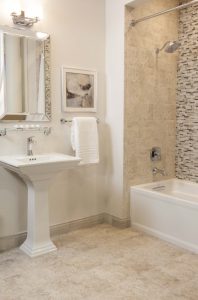 Wrong! In all other areas of the home, the primary purpose of baseboards is to protect the bottom of the wall. For most homes, this means protecting the bottom of the drywall from being destroyed.
Wrong! In all other areas of the home, the primary purpose of baseboards is to protect the bottom of the wall. For most homes, this means protecting the bottom of the drywall from being destroyed.
In the bathroom, baseboards serve a more important function. Like the other parts of the house, baseboards in the bathroom protect the bottom of the drywall. However, their most important job is keeping water out of the walls. Consider for a moment the baseboards in your bathroom. Are your baseboards near the shower, bathtub, or toilet falling apart or swelling? Is the drywall above the baseboard in these areas crumbling? Do you see black mold forming around these areas? If you answer “yes” to either of these questions, you have the wrong baseboard in the bathroom.
When Type of baseboards in the Bathroom Should I Use?
There are basically six types of baseboards. All are sold by the linear foot (LF). These six types of baseboards are readily available. Only one is considered ideal for a bathroom. Baseboards in the bathroom can be placed into three categories. These are tile, wood, and composite.
Tile Baseboards
Tile – High quality porcelain tile baseboards when correctly installed offer the best and ideal protection in the bathroom. They provide a seamless, almost  waterproof barrier.
waterproof barrier.
They never require painting and provide the most attractive finish with zero maintenance.
Wood Baseboards
Wood baseboards can be solid, fibrous, or interlocking. High quality wood baseboards paint or stain well depending on their material composition.
 Solid Wood, Oak – Beautiful wood grain with a rustic flair. Can be stained or finished clear. This hardwood resists damage from day-to-day use. Maple is also a popular choice when a natural hardwood is desired. Will turn blackish when subjected to excessive and prolonged contact with moisture. Inviting to insects such as termites after prolonged exposure to moisture.
Solid Wood, Oak – Beautiful wood grain with a rustic flair. Can be stained or finished clear. This hardwood resists damage from day-to-day use. Maple is also a popular choice when a natural hardwood is desired. Will turn blackish when subjected to excessive and prolonged contact with moisture. Inviting to insects such as termites after prolonged exposure to moisture. MDF – Medium Density Fiberboard is made using sawdust and glue. MDF is very economical and easy to work with. MDF baseboard is installed more than any other product because of its low cost and wide selection of styles. Unfortunately, MDF is the worst product to install in the bathroom. With MDF, expect to see moisture, mold, and rot problems develop soon after installation. This is especially true in heavily used bathrooms.
MDF – Medium Density Fiberboard is made using sawdust and glue. MDF is very economical and easy to work with. MDF baseboard is installed more than any other product because of its low cost and wide selection of styles. Unfortunately, MDF is the worst product to install in the bathroom. With MDF, expect to see moisture, mold, and rot problems develop soon after installation. This is especially true in heavily used bathrooms. Finger Joint – Typically made using pine. It is easy to install with basic tools and accepts paint well. Strong, durable, and a good value. Works well when creating built up baseboards. As with any wood product, absorbs moisture easily and transfers this moisture to the homes drywall and framing inside the walls. Mold, mildew, and rot are common after becoming wet.
Finger Joint – Typically made using pine. It is easy to install with basic tools and accepts paint well. Strong, durable, and a good value. Works well when creating built up baseboards. As with any wood product, absorbs moisture easily and transfers this moisture to the homes drywall and framing inside the walls. Mold, mildew, and rot are common after becoming wet.
Composite Baseboards
Composite baseboards are manufactured using a dense architectural compound. These baseboards are exceptionally durable and 100% waterproof. The material can be sanded and shaped just like wood.
 Polyurethane – A reasonable second choice for the bathroom. Unlike a tile baseboard, it will not provide a waterproof barrier between the floor and wall. Polyurethane is a plastic foam material that is resistant to moisture, insects, peeling and splitting. It has sharp design clarity with almost limitless pattern options. The high-density material enjoys lasting durability. Most solvents and household chemicals can attack and dissolve Polyurethane.
Polyurethane – A reasonable second choice for the bathroom. Unlike a tile baseboard, it will not provide a waterproof barrier between the floor and wall. Polyurethane is a plastic foam material that is resistant to moisture, insects, peeling and splitting. It has sharp design clarity with almost limitless pattern options. The high-density material enjoys lasting durability. Most solvents and household chemicals can attack and dissolve Polyurethane. PVC – Very durable and easy to clean and maintain. It is intended for outdoor use. PVC is an ideal long-term product for outside windows, doors, garage surrounds, trim, fascia, and decorative molding. PVC is moisture proof, termite proof, and does not promote mold and mildew. PVC enjoys superior nailing and gluing.
PVC – Very durable and easy to clean and maintain. It is intended for outdoor use. PVC is an ideal long-term product for outside windows, doors, garage surrounds, trim, fascia, and decorative molding. PVC is moisture proof, termite proof, and does not promote mold and mildew. PVC enjoys superior nailing and gluing.
PVC has limited design options. It is more expensive overall to install. Like wood and composite products, it does not stop moisture from entering your bathroom walls from under the molding itself. This product should not be used inside the house.
How much does baseboard cost?
Width, detail, and quality of materials used during the manufacturing process have a significant impact on cost. The price for the most common 3-inch-wide baseboards is about:
- Tile – $3.50 per LF
- Polyurethane – $3.30 per LF
- Solid Wood, Oak – $2.75 per LF
- MDF – $2.46 per LF
- Finger Joint – $1.43 per LF
- PVC – $1.67 per LF
Painting Baseboards in the Bathroom
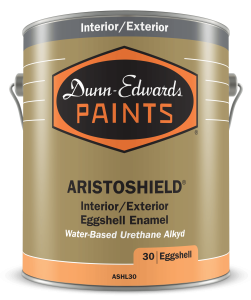 Most baseboards come pre-primed white. This is a bit of a misnomer. The primer is a filler. Its primary purpose as a heavy bonded primer is to make the exterior of the baseboard smooth and free of blemishes. Although very appealing to the touch and eye, this allows manufacturers to use lower grade materials and manufacturing processes when making their baseboards. The “primer” then hides the substandard baseboard material. I have seen this in almost all the baseboards I’ve worked with from Asian countries.
Most baseboards come pre-primed white. This is a bit of a misnomer. The primer is a filler. Its primary purpose as a heavy bonded primer is to make the exterior of the baseboard smooth and free of blemishes. Although very appealing to the touch and eye, this allows manufacturers to use lower grade materials and manufacturing processes when making their baseboards. The “primer” then hides the substandard baseboard material. I have seen this in almost all the baseboards I’ve worked with from Asian countries.
An experienced installer can guide you to the better-quality products. To the inexperienced eye, it all looks the same. The only difference being price.
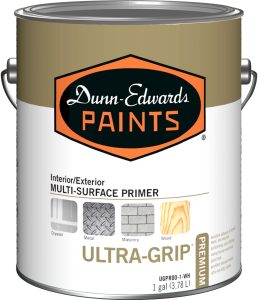 Prior to painting any baseboard molding, you must properly prepare the surface using an appropriate ultra-premium primer. Skipping this critical step and your baseboards will not long survive the high moisture environment typically found in bathrooms.
Prior to painting any baseboard molding, you must properly prepare the surface using an appropriate ultra-premium primer. Skipping this critical step and your baseboards will not long survive the high moisture environment typically found in bathrooms.
Always use a premium high-quality urethane alkyd or acrylic latex paint on paintable baseboards. On stain grade baseboards, use a high-quality stain and clear oil-based Spar Urethane.
Always Hire a Reliable and Dependable Contractor to Remodel your Bathroom
 Always work with a trustworthy contractor like DAD’s Construction. We are experts in bathroom remodeling who can manage projects in an efficient manner. DAD’s Construction will do everything to minimize the possibility of change orders. Our team will make sure we have all the necessary information to prepare a proposal that meets your requirements. Rest assured that we will provide you with a detailed, by line-item contract. We will make sure that the contents of this agreement are properly and clearly communicated to you. If you have questions or need updates regarding your project, we will always answer your inquiries.
Always work with a trustworthy contractor like DAD’s Construction. We are experts in bathroom remodeling who can manage projects in an efficient manner. DAD’s Construction will do everything to minimize the possibility of change orders. Our team will make sure we have all the necessary information to prepare a proposal that meets your requirements. Rest assured that we will provide you with a detailed, by line-item contract. We will make sure that the contents of this agreement are properly and clearly communicated to you. If you have questions or need updates regarding your project, we will always answer your inquiries.
How Can I Receive More Information on Remodeling my Bathroom?
If you would like more information on enjoying the best bathroom, kitchen, and interior remodeling experience in Orange County, call Dan at (949) 380-0177 or at dan@dadsconstruction.com for a free in home consultation. DAD’s serves all of South Orange County California. This includes Lake Forest, Mission Viejo, Foothill Ranch, Portola Hills, Ladera Ranch, Irvine, San Clemente, Dana Point, San Juan Capistrano, Rancho Santa Margarita, Coto de Caza, Dove Canyon, Laguna Niguel, Laguna Hills, Newport Beach, and Aliso Viejo.
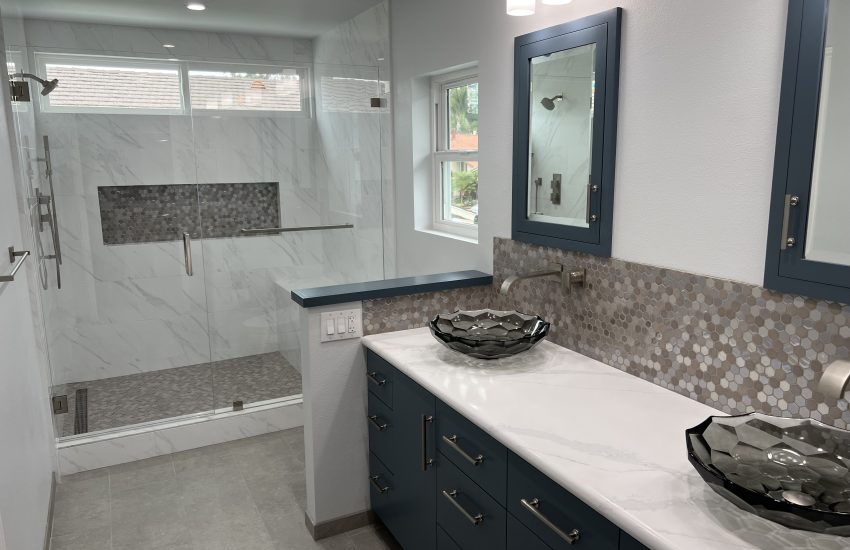
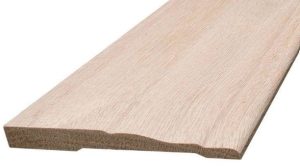 Solid Wood, Oak – Beautiful wood grain with a rustic flair. Can be stained or finished clear. This hardwood resists damage from day-to-day use. Maple is also a popular choice when a natural hardwood is desired. Will turn blackish when subjected to excessive and prolonged contact with moisture. Inviting to insects such as termites after prolonged exposure to moisture.
Solid Wood, Oak – Beautiful wood grain with a rustic flair. Can be stained or finished clear. This hardwood resists damage from day-to-day use. Maple is also a popular choice when a natural hardwood is desired. Will turn blackish when subjected to excessive and prolonged contact with moisture. Inviting to insects such as termites after prolonged exposure to moisture.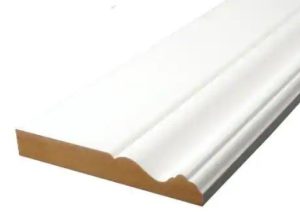 MDF – Medium Density Fiberboard is made using sawdust and glue. MDF is very economical and easy to work with. MDF baseboard is installed more than any other product because of its low cost and wide selection of styles. Unfortunately, MDF is the worst product to install in the bathroom. With MDF, expect to see moisture, mold, and rot problems develop soon after installation. This is especially true in heavily used bathrooms.
MDF – Medium Density Fiberboard is made using sawdust and glue. MDF is very economical and easy to work with. MDF baseboard is installed more than any other product because of its low cost and wide selection of styles. Unfortunately, MDF is the worst product to install in the bathroom. With MDF, expect to see moisture, mold, and rot problems develop soon after installation. This is especially true in heavily used bathrooms.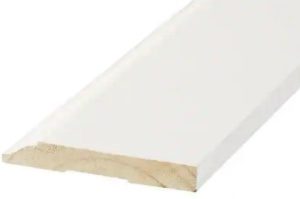 Finger Joint – Typically made using pine. It is easy to install with basic tools and accepts paint well. Strong, durable, and a good value. Works well when creating built up baseboards. As with any wood product, absorbs moisture easily and transfers this moisture to the homes drywall and framing inside the walls. Mold, mildew, and rot are common after becoming wet.
Finger Joint – Typically made using pine. It is easy to install with basic tools and accepts paint well. Strong, durable, and a good value. Works well when creating built up baseboards. As with any wood product, absorbs moisture easily and transfers this moisture to the homes drywall and framing inside the walls. Mold, mildew, and rot are common after becoming wet.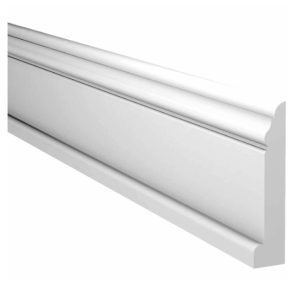 Polyurethane – A reasonable second choice for the bathroom. Unlike a tile baseboard, it will not provide a waterproof barrier between the floor and wall. Polyurethane is a plastic foam material that is resistant to moisture, insects, peeling and splitting. It has sharp design clarity with almost limitless pattern options. The high-density material enjoys lasting durability. Most solvents and household chemicals can attack and dissolve Polyurethane.
Polyurethane – A reasonable second choice for the bathroom. Unlike a tile baseboard, it will not provide a waterproof barrier between the floor and wall. Polyurethane is a plastic foam material that is resistant to moisture, insects, peeling and splitting. It has sharp design clarity with almost limitless pattern options. The high-density material enjoys lasting durability. Most solvents and household chemicals can attack and dissolve Polyurethane.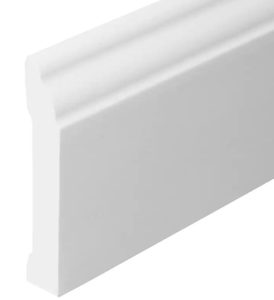 PVC – Very durable and easy to clean and maintain. It is intended for outdoor use. PVC is an ideal long-term product for outside windows, doors, garage surrounds, trim, fascia, and decorative molding. PVC is moisture proof, termite proof, and does not promote mold and mildew. PVC enjoys superior nailing and gluing.
PVC – Very durable and easy to clean and maintain. It is intended for outdoor use. PVC is an ideal long-term product for outside windows, doors, garage surrounds, trim, fascia, and decorative molding. PVC is moisture proof, termite proof, and does not promote mold and mildew. PVC enjoys superior nailing and gluing.